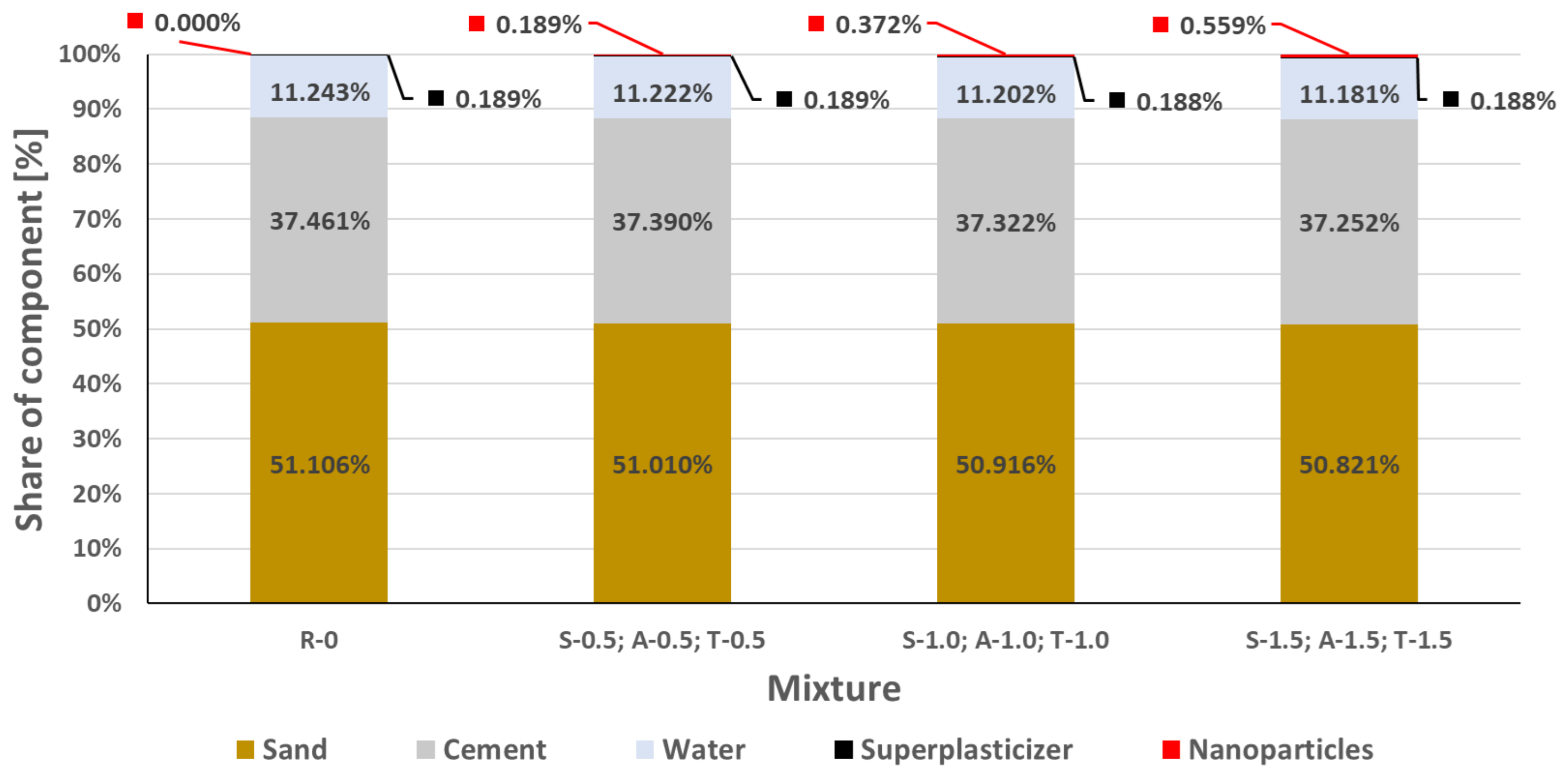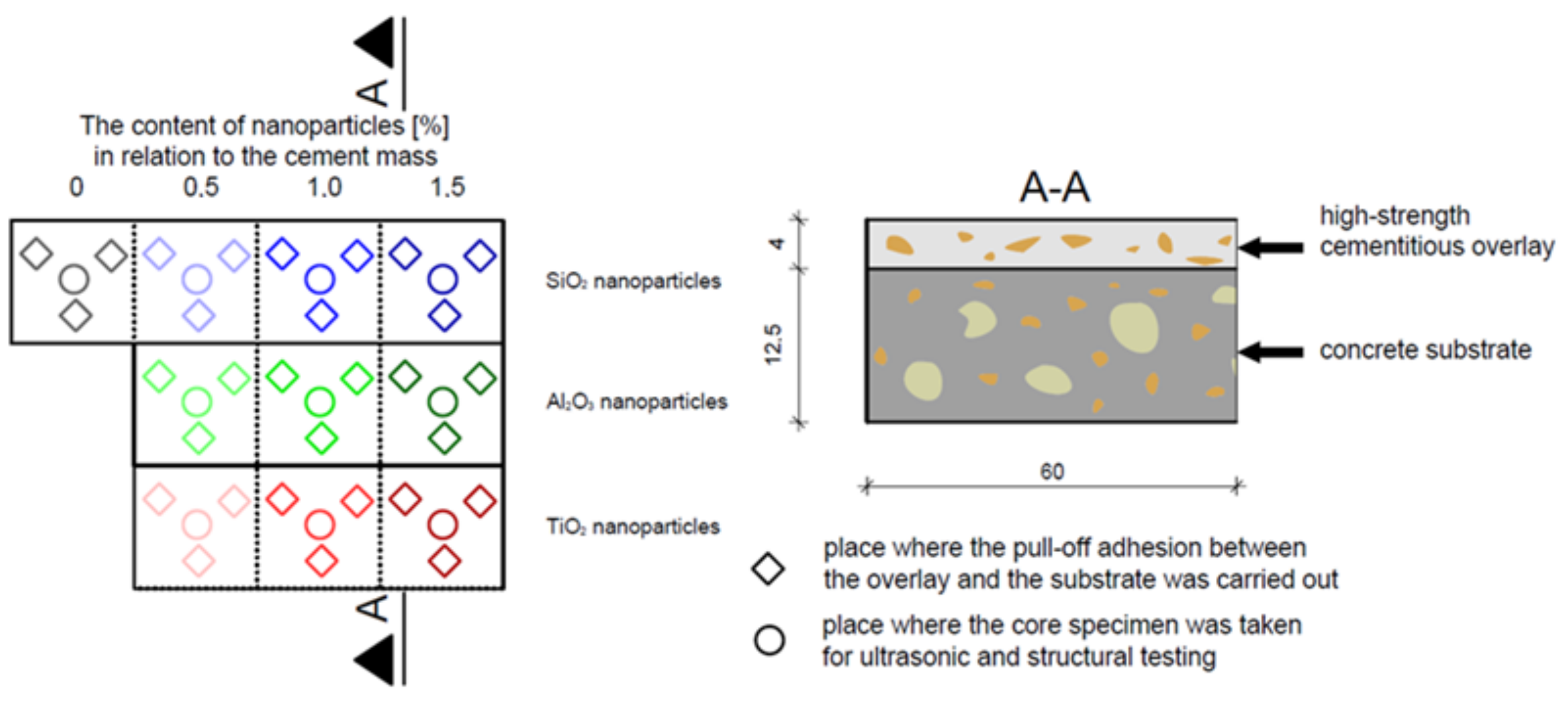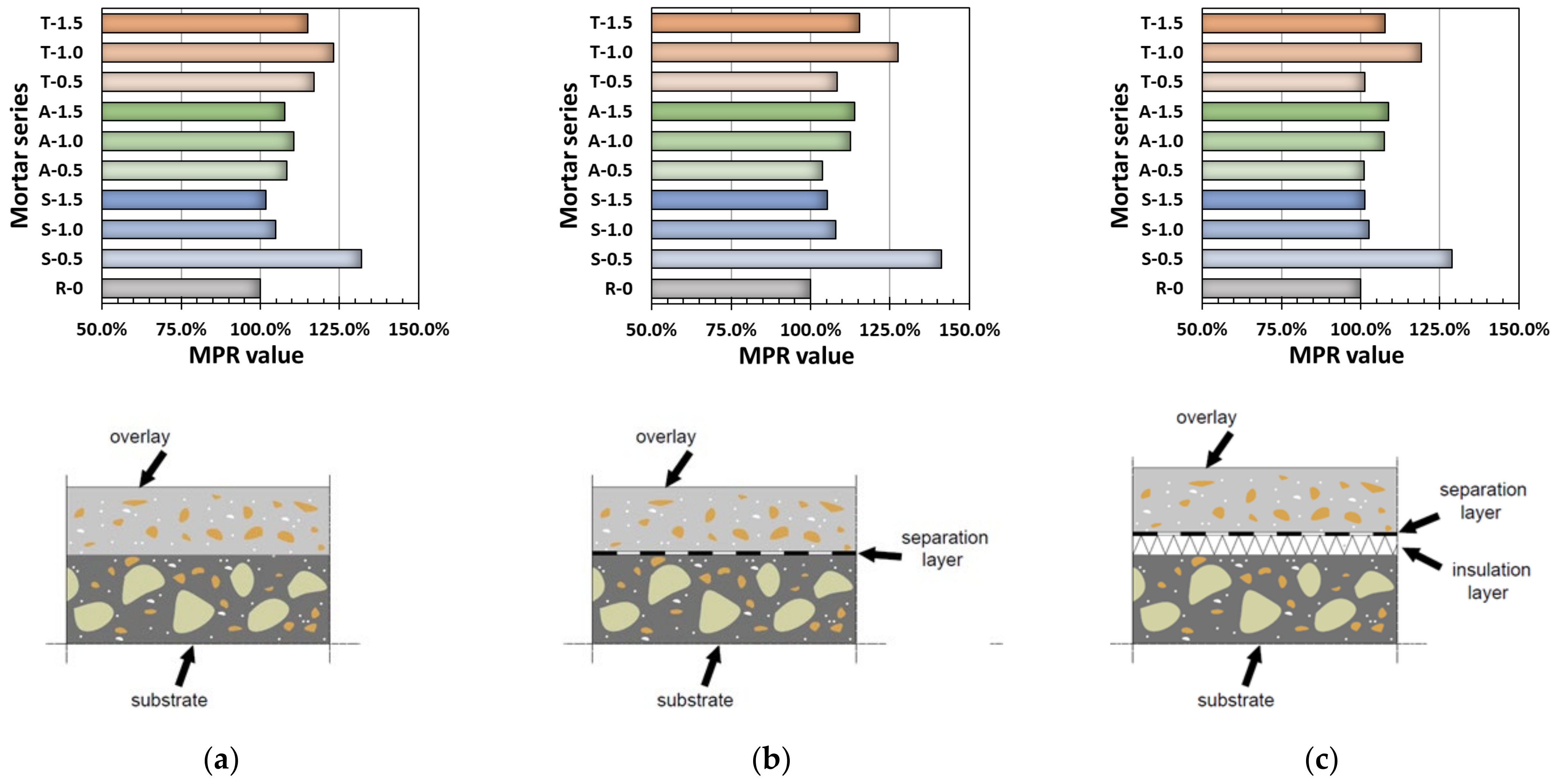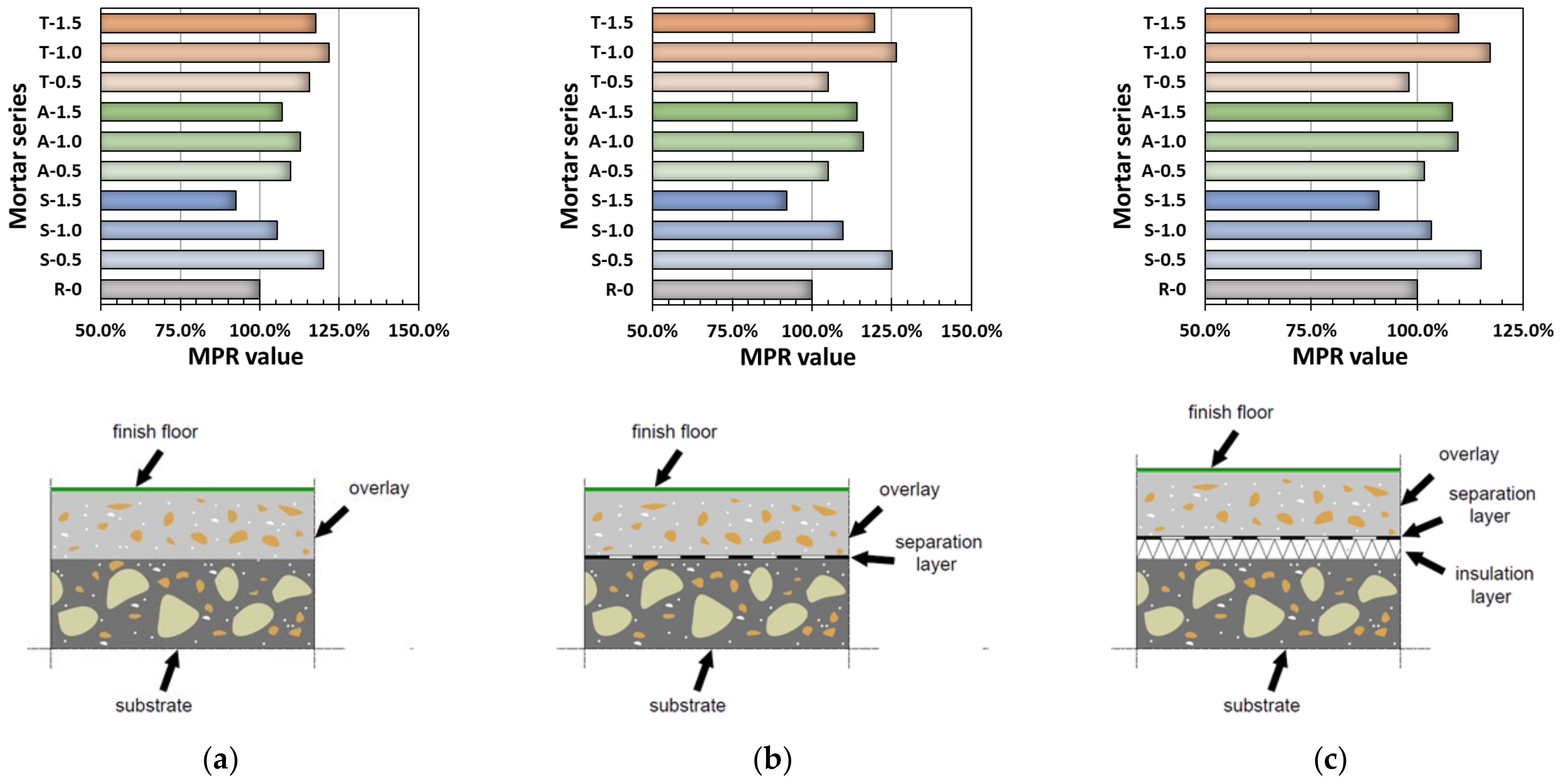Analysis of the Mechanical Performance of High-Strength Nano-Modified Cement Mortars for Overlays
Abstract
:1. Introduction
2. Materials and Methods
2.1. Floor Model Element—Preparation and Materials
2.2. Strength Properties
2.3. Adhesive Properties
2.4. Functional Properties
2.4.1. Abrasion
2.4.2. Subsurface Tensile Strength of the Overlay
2.5. Mechanical Performance Analysis
3. Results and Discussion
4. Conclusions
- If the overlay is a finishing layer, the optimal amount of addition is 0.5% of SiO2 and 1% of TiO2 nanoparticles, regardless of whether the overlay is bonded to the substrate, on the separating layer, or on the thermal insulation layer;
- In the case of the addition of Al2O3 nanoparticles, the optimal amount of the addition is 1.5% if the overlay is a finishing layer and it is on a separating layer, 1% when the overlay is bonded to the substrate, and 1.5% on the thermal insulation layer;
- In a situation where the overlay is a base for the finishing layer, the optimal amount of addition is 1% of TiO2 and 0.5% of SiO2 nanoparticles, regardless of whether the overlay is bonded to the substrate, on the separating layer, or on the thermal insulation layer;
- In the case of the addition of Al2O3 nanoparticles, the optimal amount of the addition is 1.5% if the overlay is a base for the finishing layer and it is on separating layer, 1.5% when the overlay is bonded to the substrate, and 1% on the thermal insulation layer.
Author Contributions
Funding
Data Availability Statement
Conflicts of Interest
References
- Czarnecki, L.; Van Gemert, D. Scientific basis and rules of thumb in civil engineering: Conflict or harmony? Bull. Pol. Acad. Sci. Tech. Sci. 2016, 64, 665–673. [Google Scholar] [CrossRef]
- Sadłowski, K.; Urbanowicz, D.; Warzocha, M. Podkłady podłogowe: Wymagania, projektowanie, wykonawstwo. Materiały Budowlane 2015, 11, 81–84. [Google Scholar] [CrossRef]
- Garbacz, A.; Courard, L.; Bissonnette, B. A surface engineering approach applicable to concrete repair engineering. Bull. Pol. Acad. Sci. Tech. Sci. 2013, 61, 73–84. [Google Scholar] [CrossRef]
- Felekoğlu, B.; Türkel, S.; Altuntaş, Y. Effects of steel fiber reinforcement on surface wear resistance of self-compacting repair mortars. Cem. Concr. Compos. 2007, 29, 391–396. [Google Scholar] [CrossRef]
- Franzoni, E.; Varum, H.; Natali, M.E.; Bignozzi, M.C.; Melo, J.; Rocha, L.; Pereira, E. Improvement of historic reinforced concrete/mortars by impregnation and electrochemical methods. Cem. Concr. Compos. 2014, 49, 50–58. [Google Scholar] [CrossRef]
- Grdic, Z.J.; Curcic, G.A.T.; Ristic, N.S.; Despotovic, I.M. Abrasion resistance of concrete micro-reinforced with polypropylene fibers. Constr. Build. Mater. 2012, 27, 305–312. [Google Scholar] [CrossRef]
- Beushausen, H.; Bester, N. The influence of curing on restrained shrinkage cracking of bonded concrete overlays. Cem. Concr. Res. 2016, 87, 87–96. [Google Scholar] [CrossRef]
- Canbaz, M.; Topçu, İ.B.; Ateşin, Ö. Effect of admixture ratio and aggregate type on self-leveling screed properties. Constr. Build. Mater. 2016, 116, 321–325. [Google Scholar] [CrossRef]
- Courard, L.; Piotrowski, T.; Garbacz, A. Near-to-surface properties affecting bond strength in concrete repair. Cem. Concr. Compos. 2014, 46, 73–80. [Google Scholar] [CrossRef]
- Li, G. A new way to increase the long-term bond strength of new-to-old concrete by the use of fly ash. Cem. Concr. Res. 2003, 33, 799–806. [Google Scholar] [CrossRef]
- Mohammadi, M.; Moghtadaei, R.M.; Samani, N.A. Influence of silica fume and metakaolin with two different types of interfacial adhesives on the bond strength of repaired concrete. Constr. Build. Mater. 2014, 51, 141–150. [Google Scholar] [CrossRef]
- Pan, X.; Shi, Z.; Shi, C.; Ling, T.-C.; Li, N. A review on concrete surface treatment Part I: Types and mechanisms. Constr. Build. Mater. 2017, 132, 578–590. [Google Scholar] [CrossRef]
- Santos, D.S.; Santos, P.M.; Dias-Da-Costa, D. Effect of surface preparation and bonding agent on the concrete-to-concrete interface strength. Constr. Build. Mater. 2012, 37, 102–110. [Google Scholar] [CrossRef]
- Xu, F.; Zhou, M.; Chen, J.; Ruan, S. Mechanical performance evaluation of polyester fiber and SBR latex compound-modified cement concrete road overlay material. Constr. Build. Mater. 2014, 63, 142–149. [Google Scholar] [CrossRef]
- Chajec, A.; Sadowski, Ł.; Moj, M. The adhesive and functional properties of cementitious overlays modified with granite powder. Int. J. Adhes. Adhes. 2022, 117, 103008. [Google Scholar] [CrossRef]
- Javed, A.; Gillani, S.A.A.; Abbass, W.; Riaz, M.R.; Hameed, R.; Abbas, S.; Salmi, A.; Deifalla, A.F. Mechanical Performance of Amorphous Metallic Fiber-Reinforced and Rubberized Thin Bonded Cement-Based Overlays. Sustainability 2022, 14, 8226. [Google Scholar] [CrossRef]
- Al-Kheetan, M.J.; Rahman, M.M. Integration of Anhydrous Sodium Acetate (ASAc) into Concrete Pavement for Protection against Harmful Impact of Deicing Salt. JOM 2019, 71, 4899–4909. [Google Scholar] [CrossRef]
- Ghazy, A.; Bassuoni, M.T. Shrinkage of nano-modified fly ash concrete as a repair material. ACI Mater. J. 2017, 114, 877–888. [Google Scholar] [CrossRef]
- Haruehansapong, S.; Pulngern, T.; Chucheepsakul, S. Effect of nanosilica particle size on the water permeability, abrasion resistance, drying shrinkage, and repair work properties of cement mortar containing nano-SiO2. Adv. Mater. Sci. Eng. 2017, 2017, 4213690. [Google Scholar] [CrossRef]
- Lin, Y.; Du, H. Graphene reinforced cement composites: A review. Constr. Build. Mater. 2020, 265, 120312. [Google Scholar] [CrossRef]
- Jiang, Z.; Sevim, O.; Ozbulut, O.E. Mechanical properties of graphene nanoplatelets-reinforced concrete prepared with different dispersion techniques. Constr. Build. Mater. 2021, 303, 124472. [Google Scholar] [CrossRef]
- Silva, J.J.; Ismael, R.; Carmo, R.N.F.; Lourenço, C.; Soldado, E.; Costa, H.; Júlio, E. Influence of nano-SiO2 and nano-Al2O3 additions on the shear strength and the bending moment capacity of RC beams. Constr. Build. Mater. 2016, 123, 35–46. [Google Scholar] [CrossRef]
- Sun, X.; Wu, Q.; Zhang, J.; Qing, Y.; Wu, Y.; Lee, S. Rheology, curing temperature and mechanical performance of oil well cement: Combined effect of cellulose nanofibers and graphene nano-platelets. Mater. Des. 2017, 114, 92–101. [Google Scholar] [CrossRef]
- Mondal, B.; Maity, D.; Patra, P.K. Bond Behavior between Bamboo and Normal-Strength Concrete: Experimental and Numerical Investigation. Pract. Period. Struct. Des. Constr. 2022, 27, 04022037. [Google Scholar] [CrossRef]
- Manokaran, S.; Manikkavasagan, K.; Nesappan, S.; Meenakshisundaram, H. Synthesis of chemically exfoliated reduced graphene oxide from as-grated graphite rods recovered from used household batteries for utilization in tribological applications. Proc. Inst. Mech. Eng. Part L J. Mater. Des. Appl. 2023, 237, 2068–2082. [Google Scholar] [CrossRef]
- Tjahjani, A.R.; Fulazzaky, M.A.; Jonbi, J.; Tinumbia, N.; Meutia, W.; Suraedi, D.; Ranna, P. Comparative analysis of natural nanosilica versus commercial nanosilica on compressive strength and durability of high-performance concrete. Arch. Civ. Eng. 2023, 69, 49–63. [Google Scholar] [CrossRef]
- Sasmal, S.; Sindu, B.S. Smart cementitious nanocomposites for self-sensing and continuous health monitoring of structures. In Smart Nanoconcretes and Cement-Based Materials; Elsevier: Amsterdam, The Netherlands, 2020; pp. 485–499. [Google Scholar] [CrossRef]
- Han, B.; Sun, S.; Ding, S.; Zhang, L.; Yu, X.; Ou, J. Review of nanocarbon-engineered multifunctional cementitious composites. Compos. Part A Appl. Sci. Manuf. 2015, 70, 69–81. [Google Scholar] [CrossRef]
- López-Carreño, R.-D.; Pujadas, P.; Cavalaro, S.H.; Aguado, A. Bond strength of whitetoppings and bonded overlays constructed with self-compacting high-performance concrete. Constr. Build. Mater. 2017, 153, 835–845. [Google Scholar] [CrossRef]
- Zhang, R.; Cheng, X.; Hou, P.; Ye, Z. Influences of nano-TiO2 on the properties of cement-based materials: Hydration and drying shrinkage. Constr. Build. Mater. 2015, 81, 35–41. [Google Scholar] [CrossRef]
- Du, H.; Pang, S.D. High performance cement composites with colloidal nano-silica. Constr. Build. Mater. 2019, 224, 317–325. [Google Scholar] [CrossRef]
- Sadowski, Ł. Adhesion in Layered Cement Composites; Springer: Berlin/Heidelberg, Germany, 2019; Volume 101. [Google Scholar]
- Santos, T.; Almeida, J.; Silvestre, J.; Faria, P. Life cycle assessment of mortars: A review on technical potential and drawbacks. Constr. Build. Mater. 2021, 288, 123069. [Google Scholar] [CrossRef]
- Sadowski, Ł.; Hoła, J. Non-Destructive Diagnostics of Concrete Floors: Methods and Case Studies; CRC Press: Boca Raton, FL, USA, 2022. [Google Scholar]
- Szymanowski, J. Evaluation of the Adhesion between Overlays and Substrates in Concrete Floors: Literature Survey, Recent Non-Destructive and Semi-Destructive Testing Methods, and Research Gaps. Buildings 2019, 9, 203. [Google Scholar] [CrossRef]
- Czarnecki, L.; Geryło, R.; Kuczyński, K. Concrete Repair Durability. Materials 2020, 13, 4535. [Google Scholar] [CrossRef]
- Hajduk, P. Projektowanie Podłóg Przemysłowych; Wydawnictwo Naukowe PWN: Warsaw, Poland, 2013. [Google Scholar]
- Bissonnette, B.; Courard, L.; Fowler, D.W.; Granju, J.L. Bonded Cement-Based Material Overlays for the Repair, the Lining or the Strengthening of Slabs or Pavements: State-of-the-Art Report of the RILEM Technical Committee 193-RLS; Springer Science & Business Media: Berlin/Heidelberg, Germany, 2011; Volume 3. [Google Scholar]
- Feng, S.; Xiao, H.; Liu, R.; Liu, M. The bond properties between ultra-high-performance concrete and normal strength concrete substrate: Bond macro-performance and overlay transition zone microstructure. Cem. Concr. Compos. 2022, 128, 104436. [Google Scholar] [CrossRef]
- Sabah, S.A.; Hassan, M.; Bunnori, N.M.; Johari, M.M. Bond strength of the interface between normal concrete substrate and GUSMRC repair material overlay. Constr. Build. Mater. 2019, 216, 261–271. [Google Scholar] [CrossRef]
- Kaszyńska, M. Early age properties of high-strength/high-performance concrete. Cem. Concr. Compos. 2002, 24, 253–261. [Google Scholar] [CrossRef]
- Szymanowski, J.; Sadowski, Ł. The Development of Nanoalumina-Based Cement Mortars for Overlay Applications in Concrete Floors. Materials 2019, 12, 3465. [Google Scholar] [CrossRef]
- Szymanowski, J.; Sadowski, Ł. Functional and adhesive properties of cement-based overlays modified with amorphous silica nanospheres. J. Adhes. 2019, 96, 207–228. [Google Scholar] [CrossRef]
- Szymanowski, J.; Sadowski, Ł. The influence of the addition of tetragonal crystalline titanium oxide nanoparticles on the adhesive and functional properties of layered cementitious composites. Compos. Struct. 2019, 233, 111636. [Google Scholar] [CrossRef]
- Liu, J.; Li, Q.; Xu, S. Influence of nanoparticles on fluidity and mechanical properties of cement mortar. Constr. Build. Mater. 2015, 101, 892–901. [Google Scholar] [CrossRef]
- EN 196-1:2016; Methods of Testing Cement—Part 1: Determination of Strength. European Standard: Bruessel, Belgium, 2016. Available online: https://sklep.pkn.pl/pn-en-196-1-2016-07p.html (accessed on 16 March 2019).
- BS EN 1542:1999; 1542—Products and Systems for the Protection and Repair of Concrete Structures-Test Methods-Measurement of Bond Strength by Pull-Off. British Standard Institution: London, UK, 1999.
- EN 13892-3:2005; Methods for Testing Materials for Undercoats—Part 3: Determination of Abrasion Resistance According to Bohme. European Standard: Bruessel, Belgium, 2005. Available online: https://sklep.pkn.pl/pn-en-13892-3-2015-02e.html (accessed on 16 March 2019).
- Kurda, R.; De Brito, J.; Silvestre, J.D. Combined economic and mechanical performance optimization of recycled aggregate concrete with high volume of fly ash. Appl. Sci. 2018, 8, 1189. [Google Scholar] [CrossRef]
- DIN 18560-7; Floor Screeds—Part 7: Heavy-Duty Screeds (Industrial Screeds). DIN: Berlin, Germany, 2004.
- PN-EN 13813; Screed Material and Floor Screeds—Screed Material—Properties and Requirements. PKN: Warsaw, Poland, 2003.
- Nivethitha, D.; Srividhya, S.; Dharmar, S. Review on Mechanical Properties of Cement Mortar Enhanced with Nanoparticles. Int. J. Sci. Res. 2014, 5, 913–916. [Google Scholar]
- Paul, S.C.; van Rooyen, A.S.; van Zijl, G.P.; Petrik, L.F. Properties of cement-based composites using nanoparticles: A comprehensive review. Constr. Build. Mater. 2018, 189, 1019–1034. [Google Scholar] [CrossRef]
- Ng, D.S.; Paul, S.C.; Anggraini, V.; Kong, S.Y.; Qureshi, T.S.; Rodriguez, C.R.; Liu, Q.-F.; Šavija, B. Influence of SiO2, TiO2 and Fe2O3 nanoparticles on the properties of fly ash blended cement mortars. Constr. Build. Mater. 2020, 258, 119627. [Google Scholar] [CrossRef]
- Wang, L.; Zheng, D.; Zhang, S.; Cui, H.; Li, D. Effect of Nano-SiO2 on the Hydration and Microstructure of Portland Cement. Nanomaterials 2016, 6, 241. [Google Scholar] [CrossRef]
- Faraj, R.H.; Ahmed, H.U.; Rafiq, S.; Sor, N.H.; Ibrahim, D.F.; Qaidi, S.M. Performance of Self-Compacting mortars modified with Nanoparticles: A systematic review and modeling. Clean. Mater. 2022, 4, 100086. [Google Scholar] [CrossRef]
- Roy, M.; Ray, I.; Davalos, J.F. High-Performance Fiber-Reinforced Concrete: Development and Evaluation as a Repairing Material. J. Mater. Civ. Eng. 2014, 26, 04014074. [Google Scholar] [CrossRef]








| Principal Properties of Cementitious Overlays | Mechanical Performance Class | ||||||||||||
|---|---|---|---|---|---|---|---|---|---|---|---|---|---|
| Strength properties | Compressive strength [MPa] | ||||||||||||
| C5 | C7 | C12 | C16 | C20 | C25 | C30 | C35 | C40 | C50 | C60 | C70 | C80 | |
| Tensile strength [MPa] | |||||||||||||
| F1 | F2 | F3 | F4 | F5 | F6 | F7 | F10 | F15 | F20 | F30 | F40 | F50 | |
| Adhesive properties | Pull-off adhesion between overlay and substrate [MPa] | ||||||||||||
| B0.2 | B0.5 | B1.0 | B1.5 | B2.0 | |||||||||
| Functional properties | Abrasion resistance (cm3/50 cm2) | ||||||||||||
| A22 | A15 | A12 | A9 | A6 | A3 | A1.5 | |||||||
| Subsurface tensile strength [MPa] | |||||||||||||
| H0.2 | H0.5 | H1.0 | H1.5 | H2.0 | |||||||||
| Floor Variant | Principal Properties of Cementitious Overlays in Terms of Their Mechanical Performance | ||||
|---|---|---|---|---|---|
| Strength Properties | Adhesive Properties | Functional Properties | |||
| Compressive Strength | Tensile Strength | Pull-Off Adhesion between Overlay and Substrate | Abrasion | Subsurface Tensile Strength | |
| The overlay is the finish floor | |||||
| On concrete substrate | ◌ | ◌ | ● | ● | O |
| On separation layer | ◌ | ◌ | - | ● | O |
| On the insulation layer | ◌ | ● | - | ● | O |
| The overlay is the substrate for the finish floor | |||||
| On concrete substrate | O | ◌ | ● | - | ● |
| On separation layer | O | ◌ | - | - | ● |
| On the insulation layer | O | ● | - | - | ● |
Disclaimer/Publisher’s Note: The statements, opinions and data contained in all publications are solely those of the individual author(s) and contributor(s) and not of MDPI and/or the editor(s). MDPI and/or the editor(s) disclaim responsibility for any injury to people or property resulting from any ideas, methods, instructions or products referred to in the content. |
© 2024 by the authors. Licensee MDPI, Basel, Switzerland. This article is an open access article distributed under the terms and conditions of the Creative Commons Attribution (CC BY) license (https://creativecommons.org/licenses/by/4.0/).
Share and Cite
Szymanowski, J.; Sadowski, Ł. Analysis of the Mechanical Performance of High-Strength Nano-Modified Cement Mortars for Overlays. Buildings 2024, 14, 248. https://doi.org/10.3390/buildings14010248
Szymanowski J, Sadowski Ł. Analysis of the Mechanical Performance of High-Strength Nano-Modified Cement Mortars for Overlays. Buildings. 2024; 14(1):248. https://doi.org/10.3390/buildings14010248
Chicago/Turabian StyleSzymanowski, Jacek, and Łukasz Sadowski. 2024. "Analysis of the Mechanical Performance of High-Strength Nano-Modified Cement Mortars for Overlays" Buildings 14, no. 1: 248. https://doi.org/10.3390/buildings14010248







